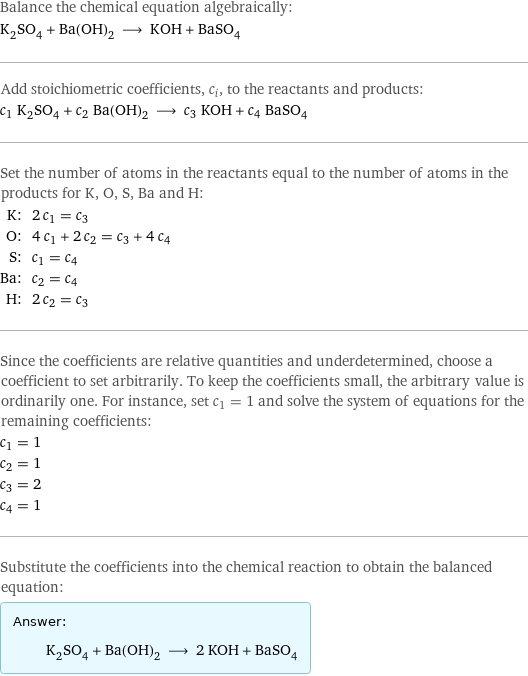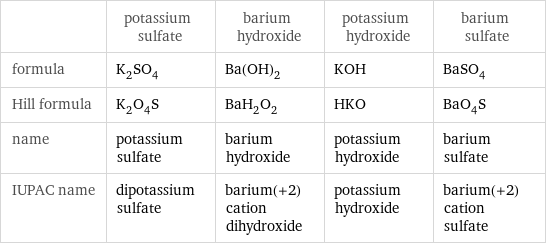Input interpretation

K_2SO_4 potassium sulfate + Ba(OH)_2 barium hydroxide ⟶ KOH potassium hydroxide + BaSO_4 barium sulfate
Balanced equation

Balance the chemical equation algebraically: K_2SO_4 + Ba(OH)_2 ⟶ KOH + BaSO_4 Add stoichiometric coefficients, c_i, to the reactants and products: c_1 K_2SO_4 + c_2 Ba(OH)_2 ⟶ c_3 KOH + c_4 BaSO_4 Set the number of atoms in the reactants equal to the number of atoms in the products for K, O, S, Ba and H: K: | 2 c_1 = c_3 O: | 4 c_1 + 2 c_2 = c_3 + 4 c_4 S: | c_1 = c_4 Ba: | c_2 = c_4 H: | 2 c_2 = c_3 Since the coefficients are relative quantities and underdetermined, choose a coefficient to set arbitrarily. To keep the coefficients small, the arbitrary value is ordinarily one. For instance, set c_1 = 1 and solve the system of equations for the remaining coefficients: c_1 = 1 c_2 = 1 c_3 = 2 c_4 = 1 Substitute the coefficients into the chemical reaction to obtain the balanced equation: Answer: | | K_2SO_4 + Ba(OH)_2 ⟶ 2 KOH + BaSO_4
Structures

+ ⟶ +
Names

potassium sulfate + barium hydroxide ⟶ potassium hydroxide + barium sulfate
Equilibrium constant
![Construct the equilibrium constant, K, expression for: K_2SO_4 + Ba(OH)_2 ⟶ KOH + BaSO_4 Plan: • Balance the chemical equation. • Determine the stoichiometric numbers. • Assemble the activity expression for each chemical species. • Use the activity expressions to build the equilibrium constant expression. Write the balanced chemical equation: K_2SO_4 + Ba(OH)_2 ⟶ 2 KOH + BaSO_4 Assign stoichiometric numbers, ν_i, using the stoichiometric coefficients, c_i, from the balanced chemical equation in the following manner: ν_i = -c_i for reactants and ν_i = c_i for products: chemical species | c_i | ν_i K_2SO_4 | 1 | -1 Ba(OH)_2 | 1 | -1 KOH | 2 | 2 BaSO_4 | 1 | 1 Assemble the activity expressions accounting for the state of matter and ν_i: chemical species | c_i | ν_i | activity expression K_2SO_4 | 1 | -1 | ([K2SO4])^(-1) Ba(OH)_2 | 1 | -1 | ([Ba(OH)2])^(-1) KOH | 2 | 2 | ([KOH])^2 BaSO_4 | 1 | 1 | [BaSO4] The equilibrium constant symbol in the concentration basis is: K_c Mulitply the activity expressions to arrive at the K_c expression: Answer: | | K_c = ([K2SO4])^(-1) ([Ba(OH)2])^(-1) ([KOH])^2 [BaSO4] = (([KOH])^2 [BaSO4])/([K2SO4] [Ba(OH)2])](../image_source/65d2a972996af74e63d5612e26889e5e.png)
Construct the equilibrium constant, K, expression for: K_2SO_4 + Ba(OH)_2 ⟶ KOH + BaSO_4 Plan: • Balance the chemical equation. • Determine the stoichiometric numbers. • Assemble the activity expression for each chemical species. • Use the activity expressions to build the equilibrium constant expression. Write the balanced chemical equation: K_2SO_4 + Ba(OH)_2 ⟶ 2 KOH + BaSO_4 Assign stoichiometric numbers, ν_i, using the stoichiometric coefficients, c_i, from the balanced chemical equation in the following manner: ν_i = -c_i for reactants and ν_i = c_i for products: chemical species | c_i | ν_i K_2SO_4 | 1 | -1 Ba(OH)_2 | 1 | -1 KOH | 2 | 2 BaSO_4 | 1 | 1 Assemble the activity expressions accounting for the state of matter and ν_i: chemical species | c_i | ν_i | activity expression K_2SO_4 | 1 | -1 | ([K2SO4])^(-1) Ba(OH)_2 | 1 | -1 | ([Ba(OH)2])^(-1) KOH | 2 | 2 | ([KOH])^2 BaSO_4 | 1 | 1 | [BaSO4] The equilibrium constant symbol in the concentration basis is: K_c Mulitply the activity expressions to arrive at the K_c expression: Answer: | | K_c = ([K2SO4])^(-1) ([Ba(OH)2])^(-1) ([KOH])^2 [BaSO4] = (([KOH])^2 [BaSO4])/([K2SO4] [Ba(OH)2])
Rate of reaction
![Construct the rate of reaction expression for: K_2SO_4 + Ba(OH)_2 ⟶ KOH + BaSO_4 Plan: • Balance the chemical equation. • Determine the stoichiometric numbers. • Assemble the rate term for each chemical species. • Write the rate of reaction expression. Write the balanced chemical equation: K_2SO_4 + Ba(OH)_2 ⟶ 2 KOH + BaSO_4 Assign stoichiometric numbers, ν_i, using the stoichiometric coefficients, c_i, from the balanced chemical equation in the following manner: ν_i = -c_i for reactants and ν_i = c_i for products: chemical species | c_i | ν_i K_2SO_4 | 1 | -1 Ba(OH)_2 | 1 | -1 KOH | 2 | 2 BaSO_4 | 1 | 1 The rate term for each chemical species, B_i, is 1/ν_i(Δ[B_i])/(Δt) where [B_i] is the amount concentration and t is time: chemical species | c_i | ν_i | rate term K_2SO_4 | 1 | -1 | -(Δ[K2SO4])/(Δt) Ba(OH)_2 | 1 | -1 | -(Δ[Ba(OH)2])/(Δt) KOH | 2 | 2 | 1/2 (Δ[KOH])/(Δt) BaSO_4 | 1 | 1 | (Δ[BaSO4])/(Δt) (for infinitesimal rate of change, replace Δ with d) Set the rate terms equal to each other to arrive at the rate expression: Answer: | | rate = -(Δ[K2SO4])/(Δt) = -(Δ[Ba(OH)2])/(Δt) = 1/2 (Δ[KOH])/(Δt) = (Δ[BaSO4])/(Δt) (assuming constant volume and no accumulation of intermediates or side products)](../image_source/edc7c52f30a775c98c9894287372c463.png)
Construct the rate of reaction expression for: K_2SO_4 + Ba(OH)_2 ⟶ KOH + BaSO_4 Plan: • Balance the chemical equation. • Determine the stoichiometric numbers. • Assemble the rate term for each chemical species. • Write the rate of reaction expression. Write the balanced chemical equation: K_2SO_4 + Ba(OH)_2 ⟶ 2 KOH + BaSO_4 Assign stoichiometric numbers, ν_i, using the stoichiometric coefficients, c_i, from the balanced chemical equation in the following manner: ν_i = -c_i for reactants and ν_i = c_i for products: chemical species | c_i | ν_i K_2SO_4 | 1 | -1 Ba(OH)_2 | 1 | -1 KOH | 2 | 2 BaSO_4 | 1 | 1 The rate term for each chemical species, B_i, is 1/ν_i(Δ[B_i])/(Δt) where [B_i] is the amount concentration and t is time: chemical species | c_i | ν_i | rate term K_2SO_4 | 1 | -1 | -(Δ[K2SO4])/(Δt) Ba(OH)_2 | 1 | -1 | -(Δ[Ba(OH)2])/(Δt) KOH | 2 | 2 | 1/2 (Δ[KOH])/(Δt) BaSO_4 | 1 | 1 | (Δ[BaSO4])/(Δt) (for infinitesimal rate of change, replace Δ with d) Set the rate terms equal to each other to arrive at the rate expression: Answer: | | rate = -(Δ[K2SO4])/(Δt) = -(Δ[Ba(OH)2])/(Δt) = 1/2 (Δ[KOH])/(Δt) = (Δ[BaSO4])/(Δt) (assuming constant volume and no accumulation of intermediates or side products)
Chemical names and formulas

| potassium sulfate | barium hydroxide | potassium hydroxide | barium sulfate formula | K_2SO_4 | Ba(OH)_2 | KOH | BaSO_4 Hill formula | K_2O_4S | BaH_2O_2 | HKO | BaO_4S name | potassium sulfate | barium hydroxide | potassium hydroxide | barium sulfate IUPAC name | dipotassium sulfate | barium(+2) cation dihydroxide | potassium hydroxide | barium(+2) cation sulfate
Substance properties

| potassium sulfate | barium hydroxide | potassium hydroxide | barium sulfate molar mass | 174.25 g/mol | 171.34 g/mol | 56.105 g/mol | 233.38 g/mol phase | | solid (at STP) | solid (at STP) | solid (at STP) melting point | | 300 °C | 406 °C | 1345 °C boiling point | | | 1327 °C | density | | 2.2 g/cm^3 | 2.044 g/cm^3 | 4.5 g/cm^3 solubility in water | soluble | | soluble | insoluble dynamic viscosity | | | 0.001 Pa s (at 550 °C) |
Units
